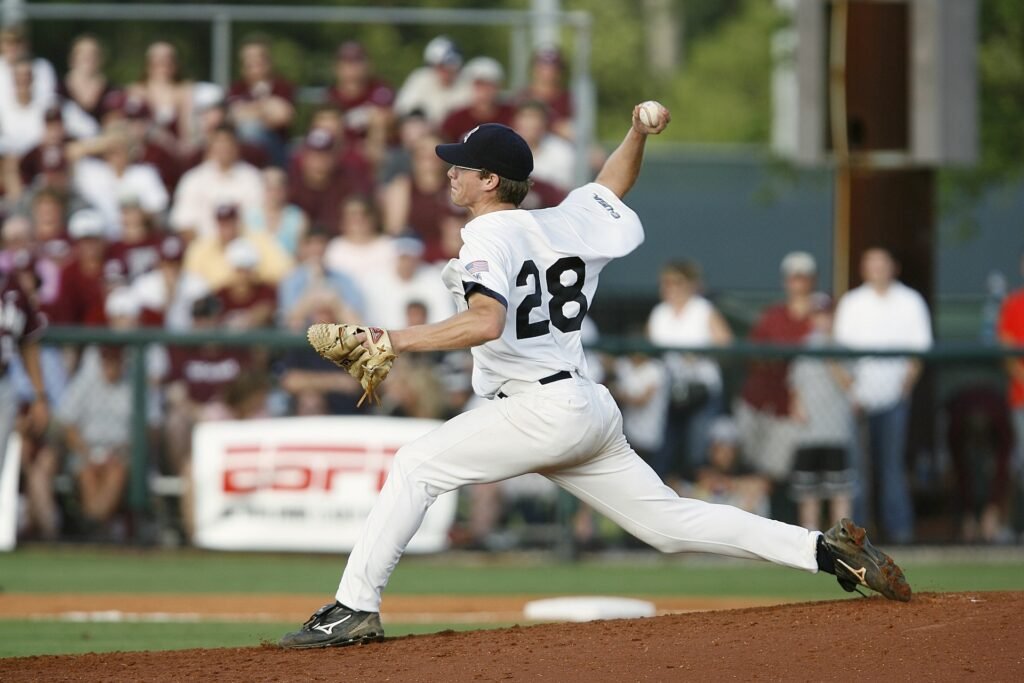what is ERA in baseball? ERA actually stands for Earned Run Average, and it’s a crucial stat in the world of baseball. It’s used to measure a pitcher’s performance and gives you a glimpse into how well they fare against opposing batters.
Essentially, ERA tells you the average number of earned runs a pitcher allows over the course of nine innings. It’s a nifty tool for comparing pitchers and assessing their skills. Whether you’re analyzing past legends or keeping tabs on current stars, understanding ERA is essential to appreciating the artistry and strategy that goes into each pitch. So, let’s dive into the world of baseball and find out what is ERA in baseball? also uncover its significance in this beloved sport.
What Is ERA in Baseball?
ERA in baseball stands for Earned Run Average as I mentioned before. It is a statistical measure used to evaluate the performance of pitchers. Simply put, ERA tells you the average number of earned runs a pitcher allows per nine innings pitched. It provides a standardized way to compare pitchers across teams and seasons.

A lower ERA indicates a more effective pitcher, as they are giving up fewer earned runs. ERA is a key metric in determining a pitcher’s skill, consistency, and overall impact on the game. It helps fans and analysts assess a pitcher’s performance, compare different eras, and recognize outstanding achievements. Whether you’re analyzing historical legends or cheering for your favorite contemporary pitcher, understanding ERA adds depth to your appreciation of the game and the artistry of pitching.
When Did ERA Originated in Baseball?
Henry Chadwick, a prominent figure in baseball history, is credited with originating ERA in baseball. Chadwick, a British-born sportswriter and statistician, introduced the concept of ERA in the late 19th century. As a passionate advocate for statistical analysis in baseball, Chadwick sought to develop a comprehensive method to assess a pitcher’s performance.
In 1874, Chadwick introduced a statistic called “Chadwick’s average” which was essentially an early form of ERA. It calculated the average number of runs allowed per game by a pitcher. Over time, this metric evolved and was refined by subsequent statisticians and analysts.
Henry Chadwick’s contributions to baseball statistics extended beyond ERA, as he played a pivotal role in popularizing scorekeeping and introducing many statistical measures that are still used today. His dedication and innovative mindset laid the foundation for the statistical analysis that is an integral part of the game we love.
What is an Earned And Unearned Run in Baseball?
In baseball, an earned run and an unearned run are two distinct types of runs that are attributed to a pitcher and their defense. Let’s break it down:
An earned run refers to a run that is scored against a pitcher due to their own performance. It is considered earned when the run is a result of hits, walks, hit-by-pitches, or other events where the defensive team is unable to prevent the runner from scoring. Essentially, if a pitcher allows a run through their own actions, it is counted as an earned run.

On the other hand, an unearned run is a run that is scored due to defensive errors, such as fielding mistakes, errors in judgment, or mishandled plays. If a defensive player commits an error, and as a result, a runner scores, the run is classified as unearned. It’s important to note that unearned runs are not attributed to the pitcher’s performance since they are a result of defensive lapses.
The distinction between earned and unearned runs helps evaluate a pitcher’s performance more accurately, as it accounts for the factors they can directly control versus those influenced by the defensive efforts behind them.
How do you calculate ERA(Earned Run Average)?
To calculate ERA (Earned Run Average) in baseball, the following formula is used:
ERA = (Earned Runs / Innings Pitched) x 9
Here’s a breakdown of the steps:
- Start by determining the number of earned runs allowed by the pitcher during a specific period of time, such as a game, season, or career.
- Next, divide the number of earned runs by the total innings pitched by the pitcher.
- Multiply the quotient by 9 to adjust the result to a per-nine-innings basis. This normalization allows for easy comparison across pitchers and different game lengths.
The resulting number represents the pitcher’s ERA, indicating the average number of earned runs they give up per nine innings pitched. A lower ERA signifies a more effective pitcher, as they are allowing fewer earned runs on average.
What Is A Good or Bad ERA?
In Major League Baseball (MLB), the evaluation of a good or bad ERA is relative and can vary based on several factors. However, there are general benchmarks that can provide some guidance.
A good ERA for a pitcher in MLB typically falls around 3.00 or lower. Pitchers with ERAs in this range are considered highly effective and are often among the top performers in the league. They consistently limit the number of earned runs they allow, helping their team maintain a competitive advantage.

On the other hand, a bad ERA is generally considered to be above 4.50 or higher. Pitchers with ERAs in this range struggle to prevent opponents from scoring and may face challenges in keeping their team in the game. However, it’s important to note that context matters, as some factors like ballpark conditions, defensive support, and league-wide offensive trends can influence ERA.
- Exceptional ERA: An exceptional ERA would typically be considered below 2.50. Pitchers with ERAs in this range are often regarded as elite and exceptional performers. They consistently demonstrate outstanding control and the ability to limit runs.
- Good ERA: A good ERA typically falls between 2.50 and 3.50. Pitchers in this range are highly effective and can be considered top performers. They consistently keep the opposition from scoring and contribute significantly to their team’s success.
- Average ERA: An average ERA usually ranges from 3.50 to 4.50. Pitchers with ERAs in this range are considered to perform at an average level. They may have occasional ups and downs but can still contribute positively to their team’s overall performance.
- Poor ERA: A poor ERA typically falls between 4.50 and 5.50. Pitchers in this range struggle to prevent opponents from scoring and may face difficulties in consistently providing quality outings. Improvement is usually desired to enhance their effectiveness.
- Very Poor ERA: A very poor ERA is generally above 5.50. Pitchers with ERAs in this range may experience significant challenges in preventing runs and often face scrutiny for their performance. Adjustments and improvement are usually necessary to become more effective.
Is low ERA is better than a high ERA?
In baseball, a low ERA is generally considered better than a high ERA. ERA, which stands for Earned Run Average, measures the average number of earned runs a pitcher allows per nine innings. A lower ERA indicates that a pitcher is more effective at preventing runs and limiting the opposition’s scoring.
Pitchers with low ERAs demonstrate better control, command, and the ability to consistently get batters out without allowing many earned runs. They are often more highly regarded and considered top performers in the league.

On the other hand, a high ERA suggests that a pitcher has been less successful in preventing runs and may struggle to control opposing hitters. A high ERA can be indicative of challenges faced by the pitcher, such as giving up too many hits, walks, or home runs.
Frequently Asked Questions
What does ERA mean in Baseball?
ERA in baseball stands for Earned Run Average. It is the average number of earned runs a pitcher allows per nine innings pitched. It measures a pitcher’s effectiveness in preventing runs.
What is a good ERA+ in baseball?
A good ERA+ in baseball typically falls above 100. ERA+ (Earned Run Average Plus) is a pitching statistic that compares a pitcher’s ERA to the league average ERA and adjusts it based on ballpark factors. An ERA+ above 100 indicates that a pitcher’s ERA is better than the league average, while an ERA+ below 100 suggests a higher ERA than the league average. The higher the ERA+, the better the performance relative to the league average. Therefore, a good ERA+ signifies a pitcher who consistently outperforms the average in preventing earned runs.
What is the lowest/ highest ERA in MLB history?
The lowest ERA in MLB history, based on qualified pitchers, belongs to Tim Keefe, who recorded an incredible 0.86 ERA in the 1880 season. Keefe, a Hall of Fame pitcher, achieved this remarkable feat during the early days of professional baseball. On the other hand, the highest ERA in MLB history, again based on qualified pitchers, is held by Bill Bergen. Bergen recorded a staggering 10.22 ERA during the 1909 season. Bergen, primarily known for his defensive skills as a catcher, struggled on the rare occasions when he took the mound.
Is ERA calculated per 9 innings?
Yes, ERA (Earned Run Average) is calculated per 9 innings pitched. It is a standard practice in baseball to express ERA on a per-nine-innings basis. This normalization allows for easy comparison and evaluation of pitchers’ performances, regardless of the length of the games they pitch in. By calculating ERA per 9 innings, it provides a consistent measure to assess how many earned runs a pitcher allows on average over the course of a full game.
Conclusion
In conclusion, ERA (Earned Run Average) is a crucial statistic in baseball, measuring a pitcher’s effectiveness in preventing earned runs per nine innings. A lower ERA indicates better performance.
Additionally, other metrics like WHIP, PO and FPS can provide further insights into a pitcher’s control and overall effectiveness. These metrics collectively help evaluate and compare pitchers, offering valuable information for fans, coaches, and analysts in understanding the nuances of the game. By considering ERA, WHIP, and FPS, we gain a more comprehensive understanding of a pitcher’s impact on the field.


